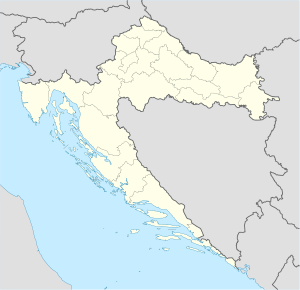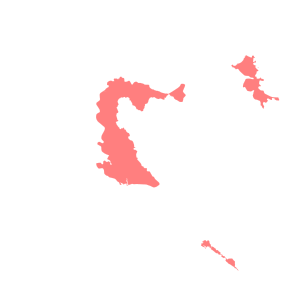1991 siege of Kijevo
| Siege of Kijevo | |||||||
|---|---|---|---|---|---|---|---|
| Part of the Croatian War of Independence | |||||||
|
The location of Kijevo within Croatia. Areas controlled by the JNA in late December 1991 are highlighted in red. |
|||||||
|
|||||||
| Belligerents | |||||||
|
|
|
||||||
| Commanders and leaders | |||||||
|
|
|
||||||
| Units involved | |||||||
| 221st Motorised Brigade SAO Krajina TO |
58 policemen | ||||||
| Casualties and losses | |||||||
| None | 20 captured 2 wounded |
||||||
The 1991 siege of Kijevo was one of the earliest conflicts in the Croatian War of Independence. The 9th Corps of the Yugoslav People's Army (Jugoslovenska Narodna Armija – JNA) led by Colonel Ratko Mladić and the forces of the Serbian Autonomous Oblast (region) of Krajina (SAO Krajina) under Knin police chief Milan Martić besieged the Croat-inhabited village of Kijevo in late April and early May 1991. The initial siege was lifted after negotiations that followed major protests in Split against the JNA.
The JNA and the SAO Krajina forces renewed the blockade in mid-August. Kijevo was captured on 26 August, and subsequently looted and burned. The fighting in Kijevo was significant as one of the first instances when the JNA openly sided with the SAO Krajina against Croatian authorities. The Croatian police fled Kijevo towards the town of Drniš and the remaining Croatian population left the village.
Martić was tried at the International Criminal Tribunal for the former Yugoslavia (ICTY) on several different charges of war crimes including, his involvement in the siege of Kijevo. The trial resulted in a guilty verdict, and the findings of the Trial Chamber regarding Kijevo, made in 2007, were confirmed by the ICTY Appeals Chamber in 2008, based on witness testimonies about it being ethnic cleansing. The siege was the first instance of use of the ethnic cleansing in the Yugoslav Wars. Croatian authorities tried Mladić in absentia and convicted him for war crimes committed in Kijevo.
In 1990, ethnic tensions between Serbs and Croats worsened after the electoral defeat of the government of the Socialist Republic of Croatia by the Croatian Democratic Union (Hrvatska demokratska zajednica, HDZ). The Yugoslav People's Army (Jugoslovenska Narodna Armija – JNA) confiscated Croatia's Territorial Defence (Teritorijalna obrana – TO) weapons to minimize resistance. On 17 August, the tensions escalated into an open revolt of the Croatian Serbs, centred on the predominantly Serb-populated areas of the Dalmatian hinterland around Knin (approximately 60 kilometres (37 miles) north-east of Split), parts of the Lika, Kordun, Banovina and eastern Croatia.Serbia, supported by Montenegro and Serbia's provinces of Vojvodina and Kosovo, unsuccessfully tried to obtain the Yugoslav Presidency's approval for a JNA operation to disarm Croatian security forces in January 1991. The request was denied and a bloodless skirmish between Serb insurgents and Croatian special police in March prompted the JNA itself to ask the Federal Presidency to give it wartime authority and declare a state of emergency. Even though the request was backed by Serbia and its allies, the JNA was denied on 15 March. Serbian President Slobodan Milošević, preferring a campaign to expand Serbia rather than to preserve Yugoslavia with Croatia as a federal unit, publicly threatened to replace the JNA with a Serbian army and declared that he no longer recognized the authority of the federal Presidency. The threat caused the JNA to gradually abandon plans to preserve Yugoslavia in favour of expansion of Serbia as the JNA came under Milošević's control. By the end of March, the conflict had escalated to the first fatalities. In early April, leaders of the Serb revolt in Croatia declared their intention to integrate areas under their control with Serbia. These were viewed by the Government of Croatia as breakaway regions.
...
Wikipedia


